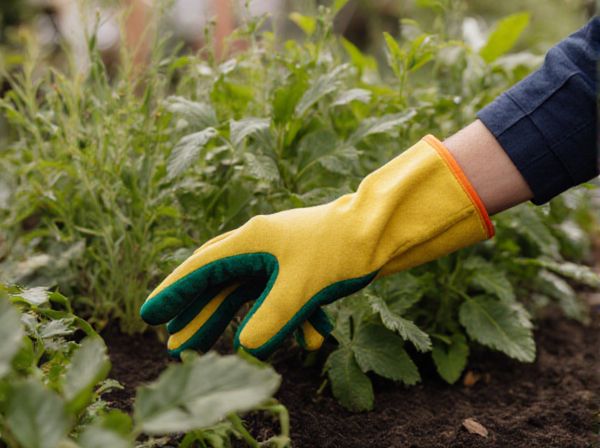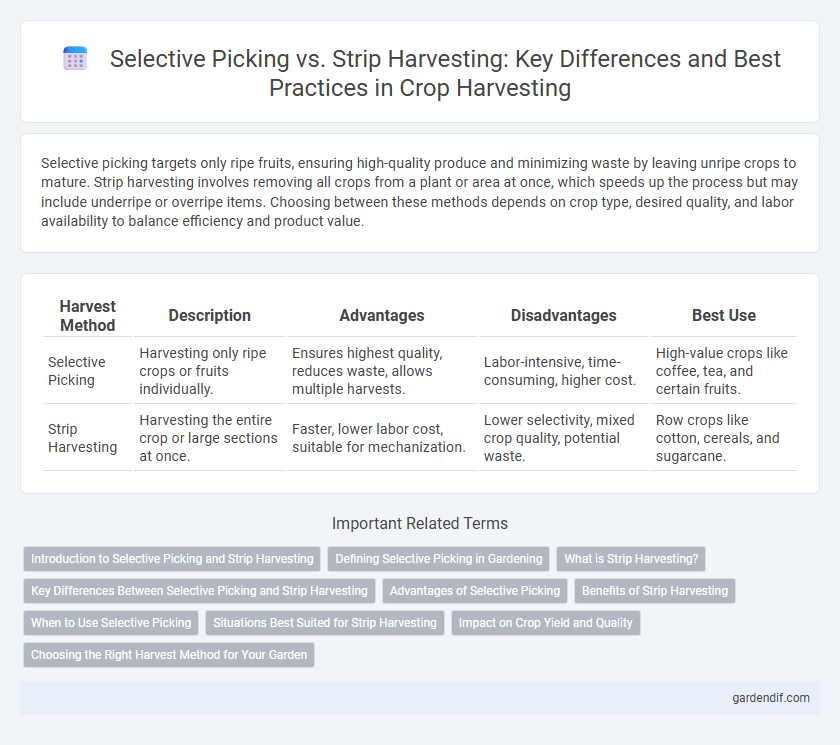
Selective Picking vs Strip Harvesting Illustration
Selective picking targets only ripe fruits, ensuring high-quality produce and minimizing waste by leaving unripe crops to mature. Strip harvesting involves removing all crops from a plant or area at once, which speeds up the process but may include underripe or overripe items. Choosing between these methods depends on crop type, desired quality, and labor availability to balance efficiency and product value.
Table of Comparison
| Harvest Method | Description | Advantages | Disadvantages | Best Use |
|---|---|---|---|---|
| Selective Picking | Harvesting only ripe crops or fruits individually. | Ensures highest quality, reduces waste, allows multiple harvests. | Labor-intensive, time-consuming, higher cost. | High-value crops like coffee, tea, and certain fruits. |
| Strip Harvesting | Harvesting the entire crop or large sections at once. | Faster, lower labor cost, suitable for mechanization. | Lower selectivity, mixed crop quality, potential waste. | Row crops like cotton, cereals, and sugarcane. |
Introduction to Selective Picking and Strip Harvesting
Selective picking involves harvesting only ripe fruits or crops from plants, allowing unripe produce to continue growing and improving overall yield quality. Strip harvesting removes entire sections or rows of crops simultaneously, which increases efficiency but may include unripe or overripe produce. Understanding the differences between selective picking and strip harvesting is essential for optimizing harvest strategies based on crop type and market demands.
Defining Selective Picking in Gardening
Selective picking in gardening involves harvesting only mature or ripe fruits and vegetables from plants while leaving the unripe ones to continue growing, optimizing crop yield and quality. This method reduces waste and promotes healthier plant development by allowing continuous production over time. Gardeners benefit from selective picking by ensuring a steady supply of fresh produce and minimizing damage to plants compared to strip harvesting, which removes all produce at once.
What is Strip Harvesting?
Strip harvesting is an agricultural technique where crops are harvested in long, continuous sections or strips rather than selecting individual plants or fruits. This method increases efficiency by enabling the use of machinery to quickly gather large quantities of produce with minimal labor. Primarily applied to crops like grains and sugarcane, strip harvesting reduces the time and costs associated with manual selective picking.
Key Differences Between Selective Picking and Strip Harvesting
Selective picking involves harvesting only ripe fruits or crops from plants, ensuring quality and minimizing waste, while strip harvesting removes all crops in a designated area regardless of ripeness. This method impacts crop quality, labor intensity, and post-harvest processing, with selective picking requiring more skilled labor but resulting in higher-quality produce. Strip harvesting is faster and more mechanized, best suited for uniform crop maturity and large-scale operations.
Advantages of Selective Picking
Selective picking enhances crop quality by targeting only ripe fruits, reducing waste and maximizing market value. This method allows for continuous harvesting throughout the season, improving yield consistency and resource efficiency. Labor costs may be higher, but the precision minimizes damage to plants, supporting sustainable growth and long-term productivity.
Benefits of Strip Harvesting
Strip harvesting maximizes efficiency by allowing rapid collection of crops in continuous swaths, reducing labor costs and time spent in the field. This method enhances machinery utilization and minimizes crop damage due to fewer passes, resulting in higher overall yield quality. Farmers benefit from improved operational flow and the ability to manage large-scale harvests effectively with strip harvesting techniques.
When to Use Selective Picking
Selective picking is ideal for crops that mature unevenly, such as coffee cherries or certain fruits, allowing harvesters to pick only ripe produce while leaving unripe ones on the plant. This method maximizes quality and reduces waste, making it suitable for high-value crops requiring multiple harvests over time. Selective picking is best employed when labor availability and crop value justify the slower, more precise process compared to strip harvesting.
Situations Best Suited for Strip Harvesting
Strip harvesting is best suited for crops with uniform ripening or when rapid harvesting is necessary to prevent losses due to weather or pests. This method is ideal for grains, legumes, and root vegetables where the entire field can be harvested efficiently in one pass. It minimizes labor costs and maximizes machine utilization in large-scale farming operations with homogeneous crop maturity.
Impact on Crop Yield and Quality
Selective picking targets only ripe fruits, preserving overall crop quality and minimizing damage, which often results in higher market value and improved yield consistency. Strip harvesting removes all crops at once, increasing efficiency but potentially lowering quality due to unripe or overripe produce inclusion. Crop yield quality is generally higher with selective picking, while strip harvesting maximizes volume but may compromise the premium grade status of the harvest.
Choosing the Right Harvest Method for Your Garden
Selective picking allows gardeners to harvest ripe fruits and vegetables individually, promoting continuous growth and reducing waste. Strip harvesting involves removing entire rows or sections at once, ideal for crops that mature uniformly and require quick collection. Choosing the right harvest method depends on the type of crop, garden size, and desired yield quality to maximize efficiency and maintain plant health.
Selective Picking vs Strip Harvesting Infographic

 gardendif.com
gardendif.com